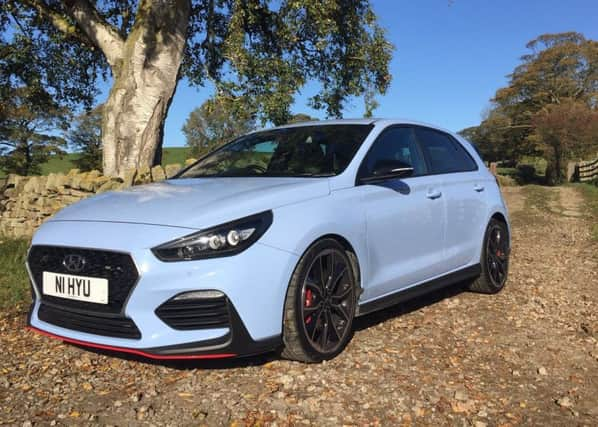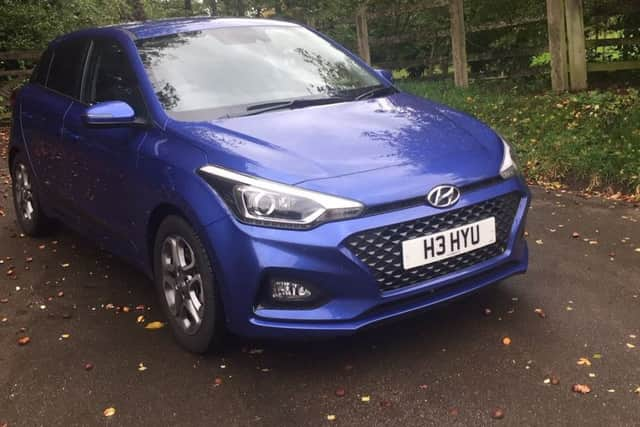Review: Hyundai i20 and i30N


First, the i20, the South Korean company’s answer to the Polo, Fiesta, Corsa, Clio, 208, Yaris and several more popular four-metre hatchbacks. Prices start at £13,995 for the recently refreshed five-door supermini. That gets you the 75ps 1.2S petrol. Standard stuff includes DAB radio, a seven inch screen, Bluetooth phone connection, rear-view camera and automatic headlamps.
My demo car was a few rungs up. The Premium Nav had a gem of an engine, the one-litre, three-cylinder petrol with GDI – gasoline direct injection. This sprays petrol directly into each cylinder to improve power and fuel efficiency. It delivers 100ps or 98.6bhp and 127 lb ft of torque. Fitted with a seven-speed dual-clutch automatic gearbox, it is rated at 56.5mpg, 114g, and 0-62mph in 11.4 seconds.
Advertisement
Hide AdAdvertisement
Hide AdI loved every mile, every minute in this car. I took it hundreds of miles up and down motorways, criss-crossed valleys, did my faux commuting run. It averages 44 to 50 miles a gallon. It ran smoothly and quietly and was a doddle to steer and use in town, helped by the eager engine and the seemingly perfect automatic gearbox.


The speed sign recognition blotted the clean sheet, though, by failing to register temporary overhead signs or long-standing 50mph average speed sections.
The interior is roomy for four, not bad for five. It is big enough for most things, nippy and potent if you want to dive and duck in and out of traffic, get a move on, without much offence. It is, after all, only a dark blue small Hyundai hatchback.
There are door pockets with irregular contours which allow packaging of things like wallets and water bottles. Much of the synthetic covering has a soft pebble finish. There is a drop-down specs holder.
For £18,945 in Champion blue, the model tested comes with navigation, electric power steering, 16-inch alloys for a comfortable ride, climate control. The headlamps have a cornering beam and high-beam assistance.
I can imagine a happy life with this car, enjoying racking up the miles in the five-year warranty.
In pale blue the i30N Performance looks misleading. The colour is actually Performance blue. Then you notice the red detailing front and back, the red brake callipers with the N logo, the 19-inch alloys with classy N spec 235-35 Pirellis, the N logo in the grille.
N stands for the Namyang R&D centre in South Korea and Nurburgring, the long distance German race track where this Hyundai and a few other N models were tested. I wonder whether British regions with good driving roads could market an appellation. Viz, H for Highlands, Y for Yorkshire or N for Northumberland.
Advertisement
Hide AdAdvertisement
Hide AdThe i30N Performance is a stonking driving car. It inherits the brand’s rally and racing pedigree. The 2-litre turbocharged petrol engine delivers 271 bhp (275ps) at 6,000rpm and 260 to 279 lb ft of torque from 1,500 to 4,700rpm.
The 0-62mph time is 6.1 seconds. Top speed is restricted at 155mph. It is rated at 163g and 39.8mpg. By coincidence, these figures are almost identical to Renault’s equally exciting Mégane R.S.
These cars, and their peers from Ford, Volkswagen and Seat, are the real deal. Like any very powerful front-wheel-drive car, they need help to get the power down cleanly – in the Hyundai an electronic limited slip differential. They have much better brakes, a lowered ride height, adjustable settings. The Hyundai has five modes, which adjust engine response, suspension stiffness, stability control, steering weight, the differential and the exhaust note. It will even blip the throttle to give a smoother down change through the six-speed gearbox. Open the boot and you see something extra, a bracing strut across the floor between the wheel arches.
It remains at heart a usable and well-equipped family hatchback – a couple of inches wider across the interior than the i20. It has smart-phone links, eight-inch navigation screen, a phone charging pad, puddle lights beaming from the gloss black door mirrors and lots more.
The pace is exciting – accompanied by a series of white, orange and finally a red band in the instrument cluster which suggest gear-change points. Driven briskly and legally it averaged 30mpg. Price: from £28,750 for the N Performance (or £25,760 for the 250ps N model). The Performance blue paint is £585.
Verdict. Two significant Hyundais, showing the strength and range of the South Korean brand. I’d live happily with either but the automatic i20 is more sensible given our speed limits.